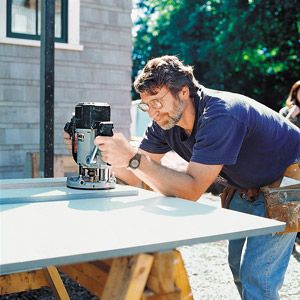
How to Avoid Burnout
I always run a test cut on a scrap of the material I’m routing first, to make sure the bit’s height is set correctly and that it’s not spinning so fast that it burns the wood. Hardwoods are most susceptible to burning from high bit speeds. You can also burn the wood if you let the router linger over one spot. Always keep the tool moving along steadily. A less common problem is setting the rpm too low, which can crush the fibers of a soft wood instead of severing them. Generally, the larger the bit diameter, the slower you set your router’s speed. Stick to the rpm range recommended by the bit manufacturer.
Working the Edges
Any time you rout an edge, steady your workpiece by clamping each end down to your worktable. Be sure the clamps are outside the path of the router’s base, and that the edge you’re routing hangs over the table enough for the bit to clear. To keep the tool steady, always place one handle over the work, and hold it down firmly. Use your other hand to press the router against the edge of the work or template, or against the straightedge that’s guiding the base. As you approach a corner, lighten the sideways pressure a bit, so you don’t go around the corner.
Norm’s Tip: When routing small pieces of wood, where clamps would get in the way, place a thick piece of foam carpet padding between the workpiece and tabletop. Slight downward pressure on the router is enough to hold the wood in place.
Feed Direction
Whenever you’re routing an outside edge, always move the tool counterclockwise around the work. That’s because router bits spin clockwise, and you want the the bit’s cutting edges to rotate into the wood for a clean cut. Don’t move the router the other way; the bit may tear the wood and the router will be hard to control. When routing the inside edge of a frame, do the reverse: Move the router around clockwise, as shown. I rout the ends of a board first, because a bit that’s moving across end grain will often “blow out” or splinter the wood when it reaches the corner. Then I go back and rout the edges that run with the grain, which gets rid of any splintering.
How to Cut a Mortise With a Plunge Router
Plunge routers are just the tool for cutting mortises, the deep slots that make up half of a mortise-and-tenon joint, or the shallow recesses that let hinge leaves sit flush with the edge of a door. In either case, you can set the router to plunge to the exact depth you want by following these steps.
1. Zero-out the tool. Unlock the router’s plunging mechanism, lower the bit until its tip just touches the work, then relock the plunging mechanism.
2. Set the depth. If you’re routing, say, a hinge mortise, place the corner of a hinge leaf flat onto the turret stop, the crenellated wheel on the router’s base directly beneath the depth-stop rod. Lower the rod until it touches the hinge. Lock the rod in place.
As you plunge the router, the depth-stop rod hits the turret, and the bit can only cut into the work by the exact thickness of the hinge plate. This same method can be used to make deeper cuts, too. To rout a ¾-inch-deep mortise, for example, just substitute a ¾-inch scrap for the hinge plate in Step 2, and lock the depth-stop rod down on it.
Bit Storage
The carbide cutting edges on router bits are superhard but brittle. All it takes to ruin them is to let them bump into each other. I store my collection on a scrap piece of ¾-inch plywood drilled with ½- and ¼-inch holes. It’s easy to make and gives me a good view of the various profiles. Just space the holes far enough apart so the bits don’t touch.
Using Two Wrenches to Loosen a Collet
Most routers these days allow you to lock in and loosen the collet with one wrench. That’s a lot more convenient than using two wrenches, the way it was when I started routing. But there are still some routers out there that require two wrenches, which means plenty of opportunity to pinch your fingers when a collet breaks free. The safest way to loosen a two-wrench collet is to remove the motor from its base, set it on its side on your worktable, and fit one wrench on the nut nearest the motor. Brace the wrench’s handle against the table as shown, so the nut can’t turn counterclockwise. Then brace the motor with one hand as you set the other wrench on the collet. Pull on that wrench, but keep your palm open to avoid pinching your fingers between the wrench handles when the collet moves. Next time, don’t overtighten the collet. Just get it snug.
Norm’s Tip: When installing a bit, push it into the collet until it hits bottom, then pull it out about 1/8 inch before tightening the collet. The bit will be more secure and easier to remove when the job is done.

